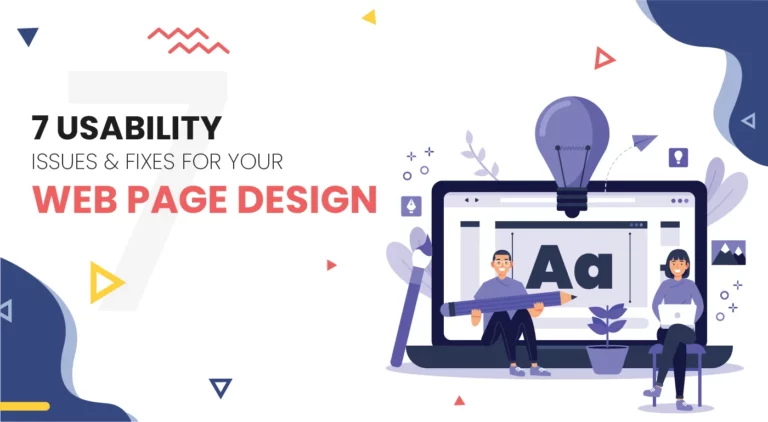7 May, 2022 | web page design
7 Usability Issues & Fixes for your web page design

-
Unclickable click sections:
When you are using the ready to implement themes for your website, this is one of the most common usability issues. The CTA buttons and clickable sections are added on the website to click and let your customers interact. But, if they aren’t working well, the opposite happens. These small click buttons turn out to be the primary reason behind users leaving your website. Since people are visiting your website across different devices, the size of the clickable button may not be easy to click.- An idea to fix: You can check the responsiveness of the theme. Further, with CSS “padding” property, you can increase the size of the clickable area or option. You can copy this code in your CSS file and apply it for different classes and id.
| <a href="https://www.examplesite.com" style="padding: 5px;">Example Site<a> |
-
Pointless use of pagination:
The concept of pagination is to split the content of a single web page to numerous pages. It is introduced with the notion to shorten the page length upto certain extent. Since lengthy pages will have more content and media elements, it can reduce the loading speed of the website. Mostly, pagination is applied for blog pages on the site.
- An idea to fix: If you are using any such tactic to improve the count of blogs or for whatever reasons, we recommend you not to follow this idea of pagination on your website.
-
Duplicate page titles:
We aren’t talking about the title of your but that of your website pages. In the development phase, we often keep deleting and adding new pages, making changes and update. But, if you are making your website live; you must be cautious about it. The title of the web page is displayed in the title bar at the head of your website. The title of your web page tells the usability of your websites to the search engines like Google, Yahoo, and others.
-
Misaligned content copy:
Since you have the basic layout of web page design ready for you, you must concentrate on improving your content copy. You have probably heard a lot that ‘content is the king’ and it’s reasonably true. You can hire the professional writers to create more personalized sales copy for your website, but your work isn’t done yet.
-
-
Ideas to fix:
- To make the most out of your website, you need to understand the interaction pattern of the visitors. If you already have a site, you can refer to the heatmaps to get a better understanding of the user behaviour.
- When you are talking about any product or service on the website, don’t just add all extent. Use some vector images, icons that tell the utility of that feature. You can add bullet points when you are listing the benefits of these features. The bite-size content is easier to digest in comparison to that of detailed pages.
- Don’t forget to check all H1, H2, H3 tags for your detailed content. You can utilize the typography options to gain the user attention towards the content. Be precise and ready to cut, whenever and wherever it seems necessary.
-
-
-
Closing doors of user interaction:
You have created your websites for the users. So, they must be open to interaction with your readers and visitors wherever possible. If you are simply creating a blog, you will be able to get the feedback. For a website dedicated to the business, the visitors can be a sales lead. That’s why the contact page is set to be mandatory for every website. By the fear of spam mails and blank calls, sometimes businesses avoid adding their contact information. The phone calls can be really irritating, but you must not remove mails.
-
-
Ideas to fix:
-
-
- You can encrypt the email that you put on the contact page, to avoid spamming.
- Make your contact number clickable so that it can be navigated to the call log directly. This increases the chance of a greater number of users interacting with you.
- Captcha codes are another barrier to smooth user interaction on any website. It’s really pathetic to give proof of your existence as a human and that too multiple times. You can replace captcha with other verification ideas like sum. It can be less tricky and easier.
-
- No search usability: Not all the people on your site are coming as a visitor. Some people already know what they are looking for, mostly this occurs on the ecommerce sites. Such customers won’t spend a long time on your web pages or even the home page. They like to search for the product and navigate to the set page directly. By not enabling the search option on your website, you will surely disappoint all those dedicated visitors. Since those visitors know what they want, they are more likely to convert.
- An idea to fix:
- As a quick fix, you can simply add the search option by looking into the theme and checking internal options. For a better view, search option must be added on the home page of the site. You don’t have to check with your developer for same. You can check for search box code on Google and try below code to improve the search feature of your website:
- An idea to fix:
| <form action="https://www.google.com/search" method="get"> <fieldset> <input type="hidden" name="sitesearch" value="wedowebapps.com" /> <input type="text" name="q" size="31" maxlength="255" value="" /> <input type="submit" value="Google Search" /> </fieldset> </form> |
-
- Here’s the search code for search box of Yahoo:
| <form action="https://search.yahoo.com/search" method="get"> <fieldset> <input type="hidden" name="vs" value="wedowebapps.com" /> <input type="text" name="p" /> <input type="submit" value="Yahoo Search" /> </fieldset> </form> |
-
Detailed registration pages:
Be it a blog platform or an ecommerce site, users like the easy options. If you think it is very much crucial for the customer to register their account, you must check your registration page. A lengthy registration page improves the chances of customers leaving your website and interacting with some other company offering similar services.
-
Ideas to fix:
-
- To improve the usability of your registration pages, you can narrow down the options displayed on the registration page. Once the user completes registration, you can drop a welcome mail and request to complete the profile. If the user is willing to make necessary changes, it will be done.
- If you are offering a free service to your customer like Pixlr, an app that allows users to create graphics and edit images for free; you can skip the login options. Also, you can keep registration as an optional thing.
- If you are running an ecommerce store, you must allow guest checkout as an option. In this way, you won’t be losing any customer just because of the registration process.
Frequently Asked Questions
there are many commonly reported usability issues encountered on web pages. Some of the biggest include slow loading times, complicated navigation menus, excessive pop-ups and ads, broken links, poor mobile optimization, confusing layouts, and unclear calls to action. These issues can frustrate users, decrease engagement, and lead to high bounce rates. It's important for web designers and developers to prioritize usability testing and continually refine their websites to ensure a positive user experience.
One common misconception about web page usability is that it's all about aesthetics. However, aesthetics are only a small part of usability. Usability is really about making sure that users can easily and efficiently accomplish their tasks on a website. Another misconception is that what's usable for one person is usable for everyone. In reality, different users have different needs and expectations, which means that usability testing must be done with a diverse group of users in order to ensure that the website works for everyone. To address these misconceptions, it's important to prioritize functionality over aesthetics when designing a website. Conducting usability testing with a diverse group of users is also critical to ensuring that the website is easy to navigate and meets the needs of all users. Additionally, it's important to keep up with current best practices in web design and usability by staying informed about industry standards and trends.
One of the most important strategies for making your website accessible is to use semantic HTML markup, which helps people with disabilities navigate your website more easily. This includes using heading tags in the correct order, labeling form fields clearly, and including alt text for images. Additionally, make sure your website is compatible with screen readers and other assistive technologies by testing it with these tools. You can also offer alternative ways to access content, such as transcripts for videos or audio descriptions for images. Lastly, make sure your website is navigable with a keyboard and avoid relying on mouse-only interactions. Consider consulting with an accessibility expert or following best-practices guidelines to ensure that your website is accessible to all users.
some common usability issues reported by users in UK-based websites include slow loading times, hard-to-navigate menus, cluttered interfaces, lack of mobile responsiveness, and confusing checkout processes. Additionally, unclear or inadequate information about products or services, conflicting information, and poor content formatting can also negatively impact user experience. It is essential for websites to prioritize user experience and constantly update and improve their site based on user feedback.
When designing a website for a UK audience, it's important to keep in mind the following best practices: 1. Use clear and concise language that is tailored to the UK audience. 2. Make sure the website is mobile-friendly, as many UK users browse on their smartphones and tablets. 3. Consider the use of local imagery, such as recognizable landmarks or cultural references. 4. Ensure that the website loads quickly, as UK internet speeds are known to be fast. 5. Incorporate easy navigation and intuitive site architecture, making it easy for users to find what they are looking for. 6. Highlight the website's security measures, as UK users are conscious of online security. 7. Provide multiple payment options, such as PayPal or credit/debit card, and ensure that the payment process is easy to follow. 8. Offer a local customer service number or chat support for UK users to easily reach customer service representatives.

